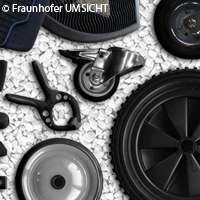Converting waste rubber into quality products

Pioneering new research is set to upset the standard paradigm of downcycling, and as a result, high-quality new plastics from old plastics will soon be a possibility.
This breakthrough is made possible thanks to a new kind of material: an environmentally friendly material mix called EPMT. Downcycling is the process of transforming waste materials - things we would throw away - into another product of lesser quality, e.g. turning a used plastic bottle into a lower grade product, or rubber residues to floor coverings or safety crash pads. This research team now hopes to upgrade this waste transformation, and has already entered talks with private enterprises to bring their innovation to commercial fruition.
Every year around the world, up to 22 million tonnes of rubber are processed, and a large portion of these goes into the production of vehicle tires. Once the products reach the end of their useful life, they typically land up in the incinerator. In a best-case scenario, the waste rubber is recycled into secondary products. Ground to powder, the rubber residues can be found, for example, in the floor coverings used at sports arenas and playgrounds, and in doormats. But until now, the appropriate techniques for producing high-quality materials from these recyclables did not exist.
Researchers at the Fraunhofer Institute for Environmental, Safety and Energy Technology UMSICHT in Oberhausen have now succeeded in optimising the recycling of rubber waste materials. They have developed a material that can be processed into high-quality products, like wheel and splashguard covers, handles, knobs and steerable castors. The new plastic compounds are called elastomer powder modified thermoplastics or EPMT for short. They are made up of rubber residues crushed into elastomer powder that are blended with thermoplastics.
Dr Holger Wack, scientist at UMSICHT, explains the production process: 'In the first step, the rubber residues, that can be meter-long rubber pieces, are granulated to three-millimetre large particles. The particles are cooled with liquid nitrogen and then ground into elastomeric powders. This is then conducted to the melt-mix process with thermoplastics and additives. Here we use, for example, polypropylene as a thermoplastic material.'
Dr Holger Wack worked in collaboration with his colleagues Damian Hintemann and Nina Kloster, on the 'EXIST Research Transfer' project sponsored by the Federal Ministry for Economics and Technology (BMWi). Together they experimented on various recipes for new blends of materials that are already protected by patent and trademark rights.
Their breakthrough has already garnered commercial interest. In the 'Re-use a Shoe' project, sports gear maker Nike has been collecting used sneakers for some time. The soles of these old sneakers are recycled under the label 'Nike Grind' and are reprocessed as filler material for sports arenas and running track surfaces. The EPMT compound generated at the Fraunhofer researchers now enables Nike to place new products on the market. And one of its official promotional partners, 'Tim Green Gifts' created the first EPMT-based promotional articles under the 'Nike Grind' brand, like frisbees, shoehorns and boomerangs. Discussions about using new EPMT compounds in the original portfolio, in the form of zippers, bag bases and sports equipment, have also been initiated. 'We are extremely excited about this collaboration,' says Wack.
The 'EPMT compound is an innovative breakthrough in more ways than one. The crushing of rubber waste is more environmentally friendly and resource-efficient than producing new rubber products - an important aspect in view of the rising costs of energy and raw materials. 'EPMT may contain up to 80 per cent residual rubber; only 20 per cent is made up by the thermoplastics,' says Wack. EPMT can be easily processed in injection mouldings and extrusion machines, and in turn, these products are themselves recyclable. The clue: The physical and mechanical material properties of the substance - like elasticity, breaking strain and hardness - can be individually modified, according to the customer's wishes.
Altogether, three basic recipes have been developed that collectively can be processed on the large technical production machines. The researchers are capable of producing 100 kilograms to 350 kilograms of EPMT per hour. Spurred on by this success, Wack and his colleagues have founded Ruhr Compounds GmbH. In addition to the production and the sale of EPMT materials, this Fraunhofer commercial spin-off offers custom-made service packages: 'We determine which of the customer's materials can be replaced by EPMT, develop customised recipes and also take into account the settings required at our customers' industrial facilities,' says the scientist. A wide array of industries will benefit from the expertise of these professionals: processors of thermoplastic elastomers can obtain EPMT and turn it into products. Industrial companies whose work involves elastomers - such as the industrial and construction sectors, or carmakers and athletics - could recycle these products, make EPMT from them, incorporate them into their existing products and thereby close the materials cycle.
Provided by CORDIS
















